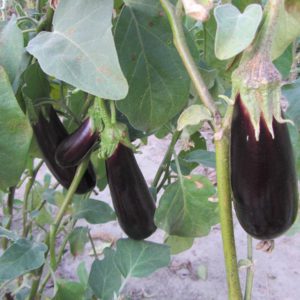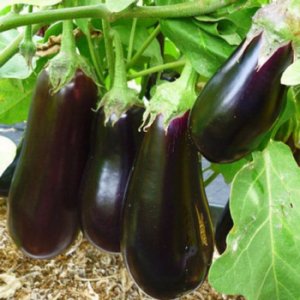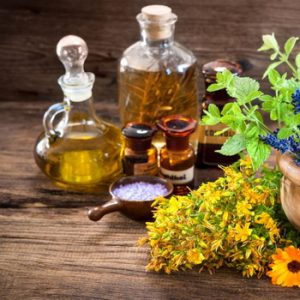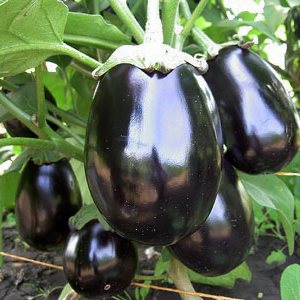Secrets of feeding eggplant for a rich harvest
Eggplants need proper and high-quality fertilization. The plant needs different amounts of nutrients depending on soil conditions, climatic conditions and stage of development.
Let's consider how to accelerate the growth of eggplants in the open field and how to feed the plants in each phase of development.
The content of the article
- What is the purpose of feeding
- Types of dressings
- How to understand what is missing in eggplant
- Secrets of feeding during the flowering period
- Features of feeding during fruiting
- In no case should you fertilize eggplants
- Important rules for feeding eggplants and advice from experienced agronomists
- Conclusion
What is the purpose of feeding
Fertilize eggplants at every stage of development. Mineral fertilizers are combined with organic fertilizers. In this way, plants receive the necessary nutrients: nitrogen, phosphorus, potassium.
When blooming
When the eggplant is in bloom, top dressing is mandatory. If it is not carried out, flowers on the plant are not formed or there are few of them. Such bushes will not bear fruit.
What kind of feeding do eggplants like during the budding period? At this time, the plants are fed with formulations containing phosphorus and potassium. Gardeners use growth stimulants. Of organic substances, preference is given to liquid mullein and ammonium nitrate.
During fruiting

During the stage of active fruiting, the plant requires nutrients such as phosphorus and potassium. Fertilize the soil only when necessary.
The soil is enriched with potassium sulfate. Infusion of poultry droppings and Nitrofoski is suitable for stimulating the fruit filling. Fertilizers are mixed with water before watering.
The rest of the time
14-21 days after planting in the ground, the seedlings are fertilized with substances containing nitrogen, phosphorus and potassium... For the rapid development of bushes, such preparations as "Solution", "Kemira" and "Kornevin" are suitable. From organics - herb infusion.
After the appearance of the first ovaries, the nutrients are doubled. From organic matter, infusion of grass, manure or ash is used. From the finished substances - preparations "Kemira", "Agricola", a solution of urea and superphosphate.
Types of dressings
Eggplants are fertilized with organic and mineral substances.
Organic matter
Organic fertilizing is applied at each stage of the growing season. They contain an optimal amount of components that dissolve well in the soil and are absorbed by plants.
Wood ash
Wood ash enriches the earth with macro- and microelements. It contains a lot of potassium. Organic fertilizer is used between feedings. Additionally, wood ash serves as an antiseptic. It disinfects the soil and protects plants from pests.
It is applied both by the root method and irrigated plantings. To do this, 150 g of ash are dissolved in 10 liters of water. The solution is insisted for 3 days, filtered and sprayed on the bushes.
Manure
Fresh mullein is used for feeding only in the form of an infusion, urea is added. In a bucket of water, dilute 1 tbsp. l. urea and add a glass of manure. The solution is insisted for 24 hours. Pour half a liter of infusion under each root.
Iodine
Iodine for eggplant in the greenhouse useful in that it helps to more actively fight various diseases. One drop of iodine is used per 10 liters of water. The resulting solution is used to cultivate the land in which they plan to plant seedlings.
Reference. Iodine is used as a fertilizer two weeks before landing.
Mineral fertilizers
Gardeners buy ready-made mineral fertilizers - both single-component and complex. In the second case, the nutrients are in a balanced form:
- Superphosphate. A complex fertilizer contains three elements: potassium, nitrogen and phosphorus (25%). A similar composition, but with a different percentage of substances, contains "Nitrofoska". Double superphosphate is useful for soils with a phosphorus deficiency.
- Ammonium sulfate. This fertilizer contains nitrogen and sulfur. It is not used on soils with high acidity, since it oxidizes them even more.
- Potassium nitrate... The fertilizer contains nitrogen and potassium. The latter increases the immunity of plants.
Folk remedies
Folk remedies are very popular among gardeners. This is a cheap method, and the necessary components are always at hand:
- Herbal infusion... The cut grass is placed in a large container and filled with water. An ordinary barrel is suitable for these purposes. The solution is insisted for a week until it ferments. The bushes are watered strictly at the root.
- Yeast. Yeast is considered a good growth promoter. For feeding eggplants 1.5 tsp. substances and 1 tbsp. l. sugar is added to 5 liters of water. Insist 3 hours and dilute with water in a ratio of 1: 5.
- Compost. Boiled potato peelings are added to 100 g of compost and diluted with water. The resulting solution is poured over the soil.
Others
To fertilize eggplants, a bread and yeast solution is used. It is a universal remedy that increases the immunity of the plant and stimulates its growth.
For the solution, take black bread, 30 g of yeast, 2 tbsp. ash, grass, lime and 500 ml of chicken manure per 10 liters of water. For a week they insist and water the beds. Top dressing is used once a week, 0.5 liters per bush.
Root fertilizers
When root dressing, fertilizers are applied at the root, avoiding contact with the leaves and stem. Mostly eggplants are fertilized with this method. Root top dressing promotes the rapid absorption of trace elements.
Important! Dilute the substances only with warm water at 23-24 ° C. If the solution gets on the leaves, they are washed with clean water.
Foliar dressing
What is eggplant foliar feeding? With this method, only the leaves are irrigated. It is rarely used. For plants on fertilized soils, root fertilization is sufficient. If the soil is scarce, foliar fertilization methods are used.
On average, 1 liter of the diluted substance is consumed for each plant. Boric acid is suitable for irrigating plants. It helps the culture with insufficient flowering and the formation of ovaries. 1 g of the substance is dissolved in 1 l of water. The bushes are irrigated twice every 10 days.
How to understand what is missing in eggplant
What element the eggplant lacks is indicated by the appearance of the plant:
- Phosphorus necessary for the development of the root system, which becomes weak under conditions of deficiency. In addition, ovaries are poorly formed and fruits ripen slowly. Leaves turn blue, curl and fall off. The plant gets sick with chlorosis. With a lack of phosphorus, superphosphate is added. Dilute 150 g of the substance into 10 liters of water.

- Nitrogen affects the growth of the plant. With a lack of this element, culture develops slowly. Small leaves of yellow or white appear on the plant, old leaves fade and fall off, the lower ones start to turn yellow from the tips to the stem. The fruits are deformed and fall off quickly. With a lack of nitrogen, the plant is fed with urea. 100 g of the substance is diluted in 10 liters of water. If you add more substances than follows according to the instructions, greens will form, while the fruits are small or do not grow.
- Potassium important for the fruiting of culture. This element increases the resistance of plants to diseases and sudden changes in temperature. With a lack of an element, young leaves turn yellow along the edges, holes appear on them. Brown spots are formed on the fruits. The plant stops bearing fruit.
- Manganese, iron and calcium affect the quality of the fruit and the yield of the plant.With a lack of iron, the leaf plates turn completely yellow. If there is not enough magnesium, the leaves become light, dark streaks become visible on them. With a lack of calcium, the metabolism of carbohydrates and proteins in tissues is poor.
Eggplants need potassium in rainy and cloudy weather. It is better to fertilize plants with ash. The substance is brought under the bush. For 1 sq. m use a glass of substance.
Secrets of feeding during the flowering period
Consider how to feed eggplants during flowering. During the period of bud formation, top dressing is applied a second time. Ready-made preparations "Kemira" and "Signor Tomato" are suitable. You can carry out nitrogen-phosphorus feeding: 1 tbsp. l. superphosphate and 1 tsp. dissolve urea in a bucket of water.
In addition to mineral fertilizers, gardeners apply organic fertilizers. 3.5-4 kg of chopped weeds, 0.5 buckets of fresh manure and a glass of ash are placed in a 50 liter barrel. Pour water to the top and cover with a lid. Insist in a warm place for a week. Before watering, the solution is diluted with water in a ratio of 1: 3 and watered with 1 liter for each seedling.
Features of feeding during fruiting
The third top dressing per season is applied when the plant bears fruit. Pour with mineral solution "Effekton". Add 0.5 liters of fertilizer to 100 liters of water. Per sq. m use 5 liters of solution.
From organic fertilizers, manure solution is suitable (1 liter of organic fertilizer per 10 liters of water). Ammonium nitrate is added to this solution. For 10 liters of substance use 1 tbsp. l. substances.
In no case should you fertilize eggplants
Depending on the phase of development, the plant requires nutrients in different proportions. It is impossible to add nitrogen more than the permissible rate specified in the instructions.
In no case should you fertilize eggplants during flowering and fruiting with fresh manure and chicken droppings. Organic fertilizer must be diluted and infused, because. the nitrogen content in these compositions is high.
Important rules for feeding eggplants and advice from experienced agronomists
In order for feeding to be successful, gardeners are advised to adhere to the following rules:
- To prolong fruiting, additional fertilizing is introduced at an interval of 14 days. Fertilize the soil with compositions with potassium: 1 tsp. potassium sulfate is dissolved in 10 l of water.
- Mineral and organic dressings alternate with each other. The mixture is carefully poured under each bush, avoiding contact with the leaves.
- Top dressing is applied after watering the plant on the same day or the next day in the morning or evening.
- A month before harvesting, a nutrient solution is poured under each bush: 1 tbsp. l. superphosphate and 1 tbsp. l. potassium salt per 10 liters of water. For each bush, 1 glass of solution is consumed.
- In order to prevent diseases and pests, eggplants are treated with fungicides.
Conclusion
For the whole season, 3-5 dressings are applied, depending on the condition of the soil and climatic conditions. During the period of bud formation and fruiting, plants are fed with substances containing phosphorus and potassium.
Fertilize eggplants with mineral and organic dressings. From organic matter, ash, mullein, iodine are used. Mineral - superphosphate, potassium salt, potassium sulfate.
Preference is given to root dressing, since this method does not allow substances to get on the leaves and harm them.